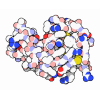[English] 日本語
 Yorodumi
Yorodumi- PDB-1jtn: Alternative Structures of a Sequence Extended T4 Lysozyme Show th... -
+ Open data
Open data
- Basic information
Basic information
| Entry | Database: PDB / ID: 1jtn | ||||||
|---|---|---|---|---|---|---|---|
| Title | Alternative Structures of a Sequence Extended T4 Lysozyme Show that the Highly Conserved Beta-Sheet Region has weak intrinsic Folding Propensity | ||||||
 Components Components | LYSOZYME | ||||||
 Keywords Keywords | HYDROLASE / SEQUENCE DUPLICATION / CONTEXT DEPENDENT FOLDING / SEQUENCE REPEAT | ||||||
| Function / homology |  Function and homology information Function and homology informationviral release from host cell by cytolysis / peptidoglycan catabolic process / cell wall macromolecule catabolic process / lysozyme / lysozyme activity / host cell cytoplasm / defense response to bacterium Similarity search - Function | ||||||
| Biological species |  Enterobacteria phage T4 (virus) Enterobacteria phage T4 (virus) | ||||||
| Method |  X-RAY DIFFRACTION / X-RAY DIFFRACTION /  SYNCHROTRON / SYNCHROTRON /  MOLECULAR REPLACEMENT / Resolution: 2.3 Å MOLECULAR REPLACEMENT / Resolution: 2.3 Å | ||||||
 Authors Authors | Sagermann, M. / Matthews, B.W. | ||||||
 Citation Citation |  Journal: J.Mol.Biol. / Year: 2002 Journal: J.Mol.Biol. / Year: 2002Title: Crystal Structures of a T4-lysozyme Duplication-extension Mutant Demonstrate that the Highly Conserved beta-Sheet Region has Low Intrinsic Folding Propensity Authors: Sagermann, M. / Matthews, B.W. #1:  Journal: Proc.Natl.Acad.Sci.USA / Year: 1999 Journal: Proc.Natl.Acad.Sci.USA / Year: 1999Title: Structural Characterization of an Engineered Tandem Repeat contrasts the Importance of Context and Sequence in Protein Folding Authors: Sagermann, M. / Baase, W.A. / Matthews, B.W. #2:  Journal: J.Mol.Biol. / Year: 1987 Journal: J.Mol.Biol. / Year: 1987Title: Structure of Bacteriophage T4 Lysozyme Refined at 1.7 A Resolution Authors: Weaver, L.H. / Matthews, B.W. | ||||||
| History |
|
- Structure visualization
Structure visualization
| Structure viewer | Molecule:  Molmil Molmil Jmol/JSmol Jmol/JSmol |
|---|
- Downloads & links
Downloads & links
- Download
Download
| PDBx/mmCIF format |  1jtn.cif.gz 1jtn.cif.gz | 84.7 KB | Display |  PDBx/mmCIF format PDBx/mmCIF format |
|---|---|---|---|---|
| PDB format |  pdb1jtn.ent.gz pdb1jtn.ent.gz | 64.9 KB | Display |  PDB format PDB format |
| PDBx/mmJSON format |  1jtn.json.gz 1jtn.json.gz | Tree view |  PDBx/mmJSON format PDBx/mmJSON format | |
| Others |  Other downloads Other downloads |
-Validation report
| Arichive directory |  https://data.pdbj.org/pub/pdb/validation_reports/jt/1jtn https://data.pdbj.org/pub/pdb/validation_reports/jt/1jtn ftp://data.pdbj.org/pub/pdb/validation_reports/jt/1jtn ftp://data.pdbj.org/pub/pdb/validation_reports/jt/1jtn | HTTPS FTP |
|---|
-Related structure data
| Related structure data | 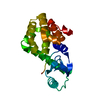 1jtmC 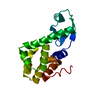 2lzmS C: citing same article ( S: Starting model for refinement |
|---|---|
| Similar structure data |
- Links
Links
- Assembly
Assembly
| Deposited unit | 
| ||||||||
|---|---|---|---|---|---|---|---|---|---|
| 1 | 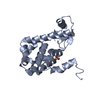
| ||||||||
| 2 | 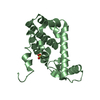
| ||||||||
| Unit cell |
| ||||||||
| Details | Molecules A and B in the asymmetric unit are related by an approximate translation. Refinement was carried out in the absence of an NCS relationship |
- Components
Components
| #1: Protein | Mass: 20221.203 Da / Num. of mol.: 2 / Mutation: C54T, C97A Source method: isolated from a genetically manipulated source Source: (gene. exp.)  Enterobacteria phage T4 (virus) / Genus: T4-like viruses / Species: Enterobacteria phage T4 sensu lato / Gene: E / Plasmid: phs1403 / Production host: Enterobacteria phage T4 (virus) / Genus: T4-like viruses / Species: Enterobacteria phage T4 sensu lato / Gene: E / Plasmid: phs1403 / Production host:  #2: Chemical | #3: Water | ChemComp-HOH / | |
|---|
-Experimental details
-Experiment
| Experiment | Method:  X-RAY DIFFRACTION / Number of used crystals: 1 X-RAY DIFFRACTION / Number of used crystals: 1 |
|---|
- Sample preparation
Sample preparation
| Crystal | Density Matthews: 2.01 Å3/Da / Density % sol: 38.92 % | |||||||||||||||||||||||||||||||||||||||||||||||||
|---|---|---|---|---|---|---|---|---|---|---|---|---|---|---|---|---|---|---|---|---|---|---|---|---|---|---|---|---|---|---|---|---|---|---|---|---|---|---|---|---|---|---|---|---|---|---|---|---|---|---|
| Crystal grow | Temperature: 298 K / Method: vapor diffusion, hanging drop / pH: 6.8 Details: 50m Tris-Glycine, 200mM Lisulfate, 18% PEG 4000, pH 6.8, VAPOR DIFFUSION, HANGING DROP, temperature 298K | |||||||||||||||||||||||||||||||||||||||||||||||||
| Crystal grow | *PLUS pH: 7.5 / Details: used microseeding | |||||||||||||||||||||||||||||||||||||||||||||||||
| Components of the solutions | *PLUS
|
-Data collection
| Diffraction | Mean temperature: 170 K |
|---|---|
| Diffraction source | Source:  SYNCHROTRON / Site: SYNCHROTRON / Site:  SSRL SSRL  / Beamline: BL9-1 / Wavelength: 0.773 Å / Beamline: BL9-1 / Wavelength: 0.773 Å |
| Detector | Type: MARRESEARCH / Detector: IMAGE PLATE / Date: Feb 23, 2001 / Details: mirrors |
| Radiation | Monochromator: FLAT MIRROR, SINGLE SI CRYSTAL BEND MONOCHROMATOR Protocol: SINGLE WAVELENGTH / Monochromatic (M) / Laue (L): M / Scattering type: x-ray |
| Radiation wavelength | Wavelength: 0.773 Å / Relative weight: 1 |
| Reflection | Resolution: 2.3→19.6 Å / Num. all: 14476 / Num. obs: 14476 / % possible obs: 98.2 % / Observed criterion σ(F): 0 / Observed criterion σ(I): 0 / Redundancy: 3 % / Biso Wilson estimate: 27 Å2 / Rsym value: 4.4 / Net I/σ(I): 13.6 |
| Reflection shell | Resolution: 2.3→2.42 Å / Redundancy: 3.6 % / Mean I/σ(I) obs: 7 / Num. unique all: 2077 / Rsym value: 0.1 / % possible all: 98.9 |
| Reflection | *PLUS % possible obs: 97.6 % / Rmerge(I) obs: 0.043 |
- Processing
Processing
| Software |
| |||||||||||||||||||||||||
|---|---|---|---|---|---|---|---|---|---|---|---|---|---|---|---|---|---|---|---|---|---|---|---|---|---|---|
| Refinement | Method to determine structure:  MOLECULAR REPLACEMENT MOLECULAR REPLACEMENTStarting model: PDB ID 2LZM Resolution: 2.3→19.6 Å / Isotropic thermal model: Anisotropic / Cross valid method: THROUGHOUT / σ(F): 0 / Stereochemistry target values: Engh & Huber Details: The structural refinement was carried out with the NCS switched off since the appended peptide of both molecules packs differently for each monomer. Residual density was observed around ...Details: The structural refinement was carried out with the NCS switched off since the appended peptide of both molecules packs differently for each monomer. Residual density was observed around residues B41 and fitted with H2O molecules. These water molecules, however, do not fit the 3.5A distance criteria. The difference density is most likely caused by PEG molecules and not by the appended peptide. The last residue of molecule A and the last four residues of molecule B were not clearly identifiable in the difference maps. A refinement with the program BUSTER showed 3 remaining residues of molecule B. Their occupancy, however, refined to low values and were therefore not included in the final model. Combination of CNS, BUSTER and TNT used for refinement.
| |||||||||||||||||||||||||
| Displacement parameters |
| |||||||||||||||||||||||||
| Refinement step | Cycle: LAST / Resolution: 2.3→19.6 Å
| |||||||||||||||||||||||||
| Refine LS restraints |
| |||||||||||||||||||||||||
| Refinement | *PLUS Rfactor all: 0.232 / Rfactor obs: 0.221 / Rfactor Rfree: 0.314 / Rfactor Rwork: 0.22 | |||||||||||||||||||||||||
| Solvent computation | *PLUS | |||||||||||||||||||||||||
| Displacement parameters | *PLUS | |||||||||||||||||||||||||
| Refine LS restraints | *PLUS Type: t_angle_deg / Dev ideal: 1.1 |
 Movie
Movie Controller
Controller


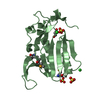

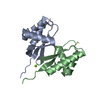
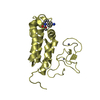
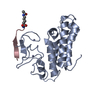
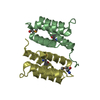


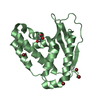

 PDBj
PDBj